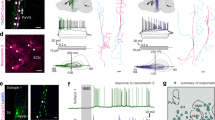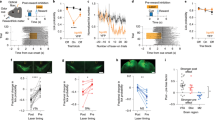Abstract
In the wild, organisms generally allocate their time among many behavioural tendencies in response to both current and anticipated motivational requirements1. However, activities that are apparently ‘irrelevant’ often intrude, either during conflict between these behavioural tendencies, or when a strong tendency is thwarted. These ‘irrelevant’ activities are called displacement behaviours and are widely documented in the ethological literature2,3. We report here that an experimental analogue of displacement behaviour in the rat depends upon the integrity of the mesolimbic dopaminergic projection to the nucleus accumbens septi, olfactory tubercle and associated structures of the forebrain4–6.
This is a preview of subscription content, access via your institution
Access options
Subscribe to this journal
Receive 51 print issues and online access
$199.00 per year
only $3.90 per issue
Buy this article
- Purchase on Springer Link
- Instant access to full article PDF
Prices may be subject to local taxes which are calculated during checkout
Similar content being viewed by others
References
McFarland, D. J. in Advances in the Study of Animal Behaviour Vol. 5 (eds Lehrman, D. S., Hinde, R. H. & Shaw, E.) 201–225 (Academic, London, 1974).
Tinbergen, N. E. Q. Rev. Biol. 27, 1–32 (1952).
Hinde, R. A. Animal Behaviour: a Synthesis of Ethology and Comparative Psychology (McGraw-Hill, New York, 1966).
Lindvall, O. & Bjorklund, A. in Handbook of Psychopharmacology Vol. 9 (eds Iversen, L. L., Iversen, S. D. & Snyder, S. H.) 139–231 (Plenum, New York, 1978).
Fallon, J. H. & Moore, R. Y. J. comp. Neurol. 180, 545–580 (1978).
Simon, H., Le Moal, M., Galey, D. & Cardo, B. Brain Res. 115, 215–231 (1976).
Falk, J. L. Physiol. Behav. 6, 577–588 (1971).
Staddon, J. E. R. & Simmelhag, V. L. Psychol. Rev. 78, 3–43 (1971).
Kachanoff, R., Leveille, R., McClelland, J. P. & Wayner, M. J. Physiol. Behav. 11, 395–398 (1973).
Killeen, P. R., Hanson, S. J. & Osbourne, S. R. Psych. Rev. 85, 571–581 (1978).
Wallace, M. & Singer, G. Pharmac. Biochem. Behav. 5, 483–490 (1976).
Wayner, M. J. Physiol. Behav. 5, 1319–1325 (1970).
Cantor, M. B. & Wilson, J. F. Learn Motiv. 9, 428–445 (1978).
Falk, J. L. in Thirst (ed. Wayner, M. J.) 95–113 (Pergamon, New York, 1964).
Teitelbaum, P. & Epstein, A. N. Psych. Rev. 69, 74–90 (1962).
Ungerstedt, U. Acta physiol. scand. Suppl. 367, 95–122 (1971).
Koob, G. F., Riley, S. J., Smith, S. C. & Robbins, T. W. J. comp. Physiol. Psychol. 92, 651–660 (1978).
Pellegrino, L. J. & Cushman, A. J. A Stereotaxic Atlas of Rat Brain (Appleton-Century-Crofts, New York, 1967).
Breese, G. R. & Traylor, T. D. Br. J. Pharmac. 42, 88–89 (1972).
Coyle, J. T. & Henry, D. J. Neurochem. 21, 61–67 (1973).
Sailer, C. F. & Zigmond, M. J. Life Sci. 23, 1117–1130 (1978).
Hendry, I. A. & Iversen, L. L. Brain Res. 29, 159–162 (1971).
Sanger, D. J. & Blackman, D. E. in Contemporary Research in Behavioural Pharmacology (ed. Blackman, D. E. & Sanger, D. J.) 239–287 (Plenum, New York, 1978).
Winer, B. J. Statistical Principles in Experimental Design 2nd edn (McGraw-Hill, New York, 1971).
Jones, D. L. & Mogenson, G. J. Eur. J. Pharmac. 59, 11–21 (1979).
Robbins, T. W. Neurosci. Lett. S58, Suppl. 1 (1978).
Kelly, P. H., Seviour, P. & Iversen, S. D. Brain Res. 94, 507–522 (1975).
Devenport, L. D. J. comp. physiol. Psychol. 92, 651–660 (1978).
Skinner, B. F. & Morse, W. H. J. comp. physiol. Psychol. 50, 279–281 (1957).
Holland, H. C. in Obsessional States (ed. Beech, H. R.) 161–173 (Methuen, London, 1974).
Thierry, A. M., Tassin, J. P., Blanc, G. & Glowinski, J. Nature 263, 242–244 (1976).
Price, K. A., Farley, I. J. & Hornykiewicz, O. in Dopamine (eds Rogers, P. J., Woodruff, G. N. & Iversen, L. L.) 293–300 (Raven, New York, 1978).
Stevens, J. R. Archs gen Psychiat. 29, 177–189 (1973).
Author information
Authors and Affiliations
Rights and permissions
About this article
Cite this article
Robbins, T., Koob, G. Selective disruption of displacement behaviour by lesions of the mesolimbic dopamine system. Nature 285, 409–412 (1980). https://doi.org/10.1038/285409a0
Received:
Accepted:
Issue Date:
DOI: https://doi.org/10.1038/285409a0
This article is cited by
-
The development of compulsive coping behavior depends on dorsolateral striatum dopamine-dependent mechanisms
Molecular Psychiatry (2023)
-
The development of compulsive coping behaviour is associated with a downregulation of Arc in a Locus Coeruleus neuronal ensemble
Neuropsychopharmacology (2023)
-
From impulses to maladaptive actions: the insula is a neurobiological gate for the development of compulsive behavior
Molecular Psychiatry (2016)
-
Cannabinoid Receptor Activation Shifts Temporally Engendered Patterns of Dopamine Release
Neuropsychopharmacology (2014)
-
The amphetamine sensitization model of schizophrenia symptoms and its effect on schedule-induced polydipsia in the rat
Psychopharmacology (2014)
Comments
By submitting a comment you agree to abide by our Terms and Community Guidelines. If you find something abusive or that does not comply with our terms or guidelines please flag it as inappropriate.



